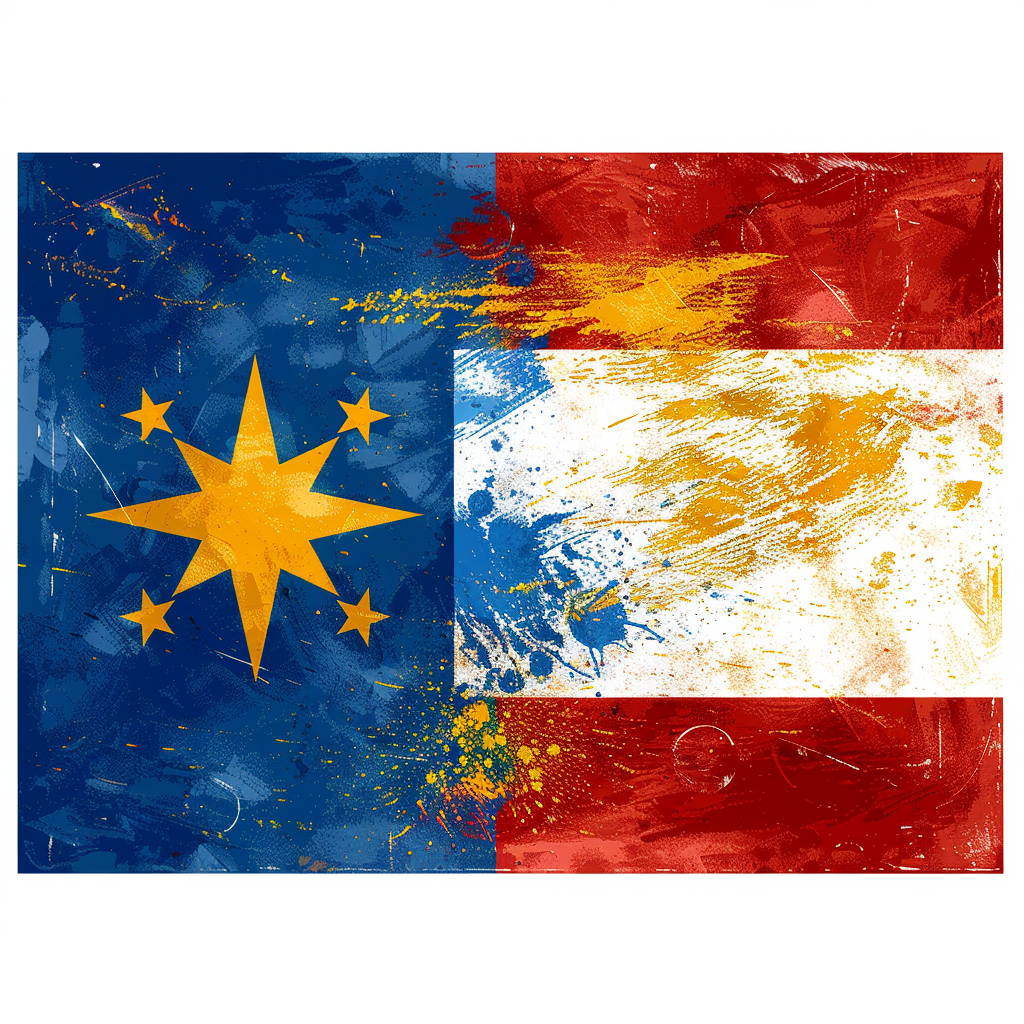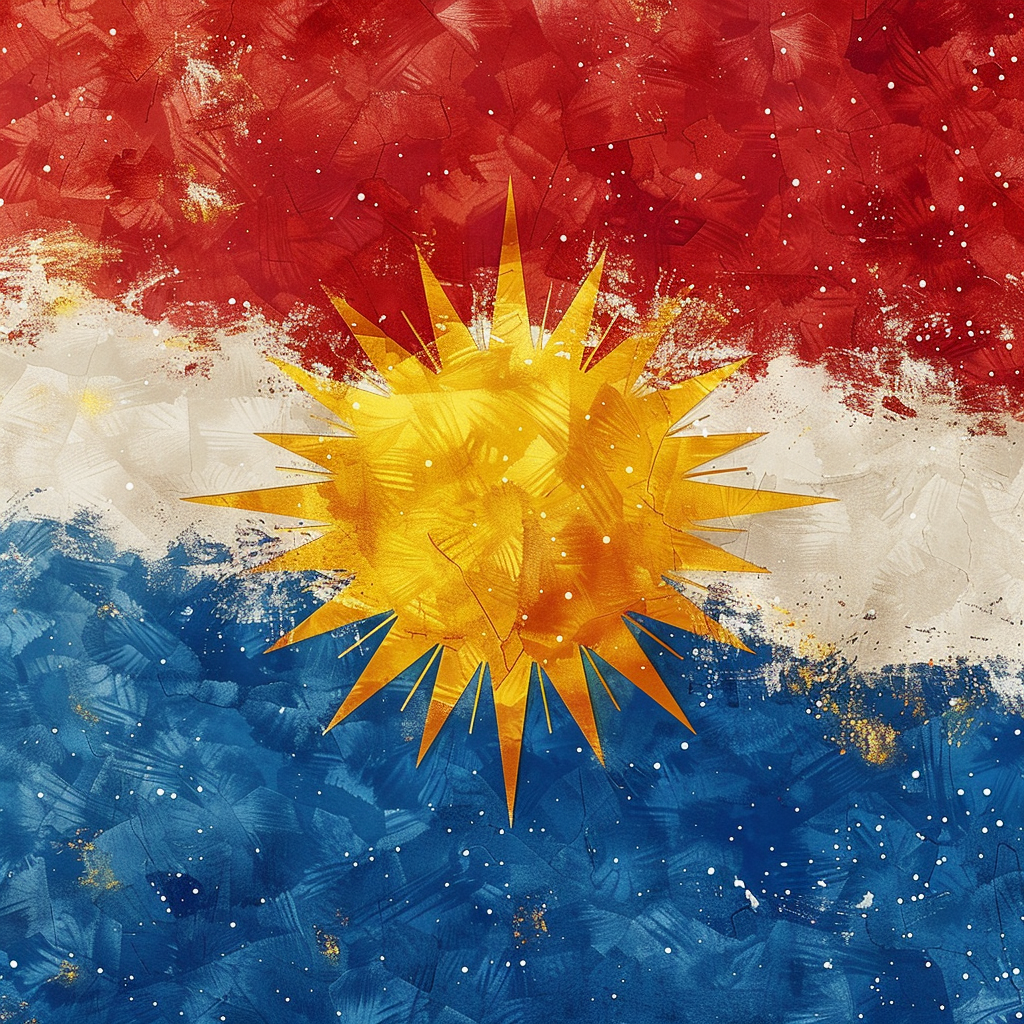The Philippines flag is not just a piece of fabric soaring in the wind it is the beating heart of a nation’s storied previous and the emblem of its unwavering spirit. With hues and symbols that echo the pulse of the Filipino men and women, the flag is a effective reminder of the country’s journey via generations of struggle, unity, and hope. For bold business people, the story of the Philippines flag is a impressive circumstance of model identity—rent with resilience, billed with enthusiasm, and unyielding in its values. It’s a flag that ties its historic richness with present day vibrancy, and as the wind picks it up, the echoes of a nation’s willpower ripple via every single wave.
Contents
The Philippines Flag’s Historical Journey of Revolt
The Philippines flag ignited its flame of revolt for the duration of the intricate dance with Spanish rule. Born out of the fervor for independence, the flag’s inception traces back to the Philippine Revolution in 1898, when Filipino revolutionaries elevated their image of liberation towards three hundreds of years of colonialism. The influence of leaders like Emilio Aguinaldo was additional than noticeable in the flag’s original layout, solidifying a basis for generations to come.
In the era when the planet was engulfed in the throes of Entire world War II, the flag morphed into a beacon of resistance towards the Japanese occupation. Its material turned a tapestry of braveness, weaving stories that would encourage a country to maintain combating and a testimony that even in the darkest of instances, the Filipino spirit would prevail.

Being familiar with the Symbolism At the rear of the Filipino Flag
Unraveling the shades of the flag, we find blue in excess of red, with white cradling an equilateral triangle at the hoist. The blue stripe aims large with peace, truth, and justice, though crimson fervently stands for patriotism and valor and white marks equality and fraternity. At the triangle’s heart is a sunshine bursting with eight principal rays, signifying the eight provinces where the anti-Spanish revolt initial ignited. Every single ray, a tale of braveness every single province, a chapter of struggle.
| Name | Pambansang Watawat ng Pilipinas (Nationwide Flag of the Philippines) |
| Adopted | June 12, 1898 |
| Proportions | 1:2 |
| Layout | Horizontal bicolor with a white equilateral triangle at the hoist |
| Hues | Royal Blue, Crimson Purple, White, Golden-Yellow |
| Symbolism | |
| Historic Context | Claimed by Ferdinand Magellan for Spain in 1521 and named right after King Philip II, revolts in opposition to Spanish rule in 1896 |
| Initial Use | Struggle of Alapan, Could 28, 1898 |
| Laws | Republic Act No. 8491, regarded as the Flag and Heraldic Code of the Philippines, mandates the correct use and reverence for the flag |
| Flag Etiquette | |
| Reversible | Traditionally, the flag can be reversed to display the pink band on best in occasions of war |
| Cost | Not relevant, but reproductions for educational or display screen applications fluctuate in cost based on dimension and product |
| Added benefits | Serves as a national symbol of pride, unity, and patriotism between Filipinos embodies the country’s struggle for independence from colonial rule |
| International Recognition | Acknowledged worldwide as the flag of the Republic of the Philippines |
Who would have thought that a flag could transcend over and above cloth into the realm of digital activism? The exceptional EDSA Men and women Ability Revolution observed the Filipino flag as a unifying icon, major to the fall of a dictator. Generations afterwards, the exact flag would develop into a digital soldier, charging into the fray of online battles with hashtags like #LabanPilipinas. And when the Anti-Terror Bill stirred the waters, there yet again was the flag, traveling superior as a image of a people’s relentless cry for independence.

Legendary Imagery: When the Philippines Flag Manufactured International Headlines
Adorning history internet pages, the Filipino flag unexpectedly identified alone amid a global controversy when footage of the 1969 Moon Landing aired, and allegiances ended up questioned. Worldwide athletics occasions see the flag uniting athletes and supporters alike, whilst at the ASEAN summits, it stands for diplomatic ties that stretch beyond oceans, embodying a perception of collective progress and regional camaraderie.
The Philippines Flag’s Authorized Protections and Controversies
Lawmakers penned Republic Act No. 8491, guaranteeing respect for this symbol of sovereignty. Still, even with this sort of steps, there have been scuffles around the flag, sparking debates that examination the boundaries of regard and liberty of expression. This dialogue is a soaring testament to the flag’s inherent electric power as an emblem that instructions the two reverence and introspection.
Educational Initiatives and the Filipino Flag
Curriculums and crash courses parade the flag’s background and the right flutter of respect that need to accompany it. On Flag Day, Filipinos’ chests swell with pleasure as strategies invigorate a nation’s patriotic fervor. In the epoch of Instagram stories and Twitter feeds, even applications turn out to be lecturers of custom, guaranteeing the youth’s relationship to the flag is as steadfast as their predecessors.
The Long run of the Philippines Flag As a Unifying Drive
With eyes seeking out to the horizon, there is a collective effort and hard work to anchor the flag deep into the soul of an at any time-globalizing Filipino modern society. As political landscapes shift like sands, a single wonders if the flag’s symbolism will shapeshift as effectively. Yet, the flag continues to be a catalyst, a property absent from residence for the Filipino diaspora scattered like stars across the world.
Pink, Blue, and Further than: The Filipino Flag’s Ongoing Narrative
The journey of the Philippines flag is a relentless voyage that mirrors the undying stamina of its people. Each and every sentiment, each and every struggle, every triumph, the flag has bore witness to it all. It envelops a nation with the fervor of the previous, the pulse of the existing, and the dreams of the long run. The Filipino flag soars—it animates the entrepreneurial spirit, counseling fortitude in uncertainty, unity in division, and eyesight in obscurity. The flag’s chronicles flap in the wind, a reminder that when contexts may perhaps adjust, the essence of a nation’s quest for which means and function will for good remain woven in its stripes.
The Multifaceted Symbolism of the Philippines Flag
The Philippines flag isn’t just a piece of fabric it is a tapestry of background woven with insurrection and identification. You may possibly not guess it, but the features of this flag can change as considerably as a mature female switching her fashion from organization stylish to night elegance. Considerably like shifting from practical duck Boots to stilettos, this flag transforms in instances of war the blue and crimson fields are flipped, signaling the country’s get in touch with to arms.
Now, is not that a thing? Just photograph a traveler, fresh from the chill vibes of Reykjavik Airport, landing in the Philippines and locating the flag in its martial arrangement—a putting metaphor for a nation’s readiness just as a crew is lined up for action like in a Psv Eindhoven Vs Sevilla fc lineup. Speak about a dynamic 1st impact!
Talking of impressions, the solar on the flag isn’t just throwing out rays willy-nilly it is got a count of eight, each and every one corresponding to a province that played a important position in the nation’s revolt in opposition to Spain. It is akin to the Elite 8 in a basketball championship, just about every team—or in this scenario, province—proving their mettle to get to the pinnacle of glory! Talking of elite, did you know that this symbolism was a notch earlier mentioned the relaxation when it comes to countrywide expectations? The structure is so entwined with the country’s wrestle that it can make other flags seem like they are just having a basic Boys haircut—functional( but without the need of that excess sizzle.
And sizzle it does, particularly when you look at how the a few stars adorning the flag are not just there to appear quite like a attractive woman at a bash. They characterize the a few important island groups—Luzon, Visayas, and Mindanao—firmly rooted in the nation’s geographical and cultural cloth.. It is not a extend to assess the balancing act of these geographical representations to the thorough deductions a enterprise has to make when filling out a W-9 form each have to have acknowledging necessary elements that make up the whole.
Lastly, although the flag waves higher, singing its vibrant tales of bravery and resilience, bear in mind it is far more than just a symbol. It is a legacy as prosperous and various as the narratives observed in Tamil Yogi movies, wrapped up in a spectrum that does additional than just flutter in the wind—it tells the timeless tale of a men and women at any time all set to stand tall for their freedom.

What is the that means of 3 stars in Philippine flag?
The a few stars on the Philippine flag symbolize the three principal geographical locations of the state: Luzon, Visayas, and Mindanao.
What does the Philippines flag characterize?
The Philippine flag embodies the country’s battle for independence, heroism, and nationwide pleasure. The white triangle signifies equality and the fraternal ideas of liberty, equality, and fraternity. The blue stripe stands for peace, truth of the matter, and justice, although the red stripe denotes patriotism and valor. The three stars represent the major island groups, and the sunlight symbolizes the dawn of a new era of self-willpower.
What is the this means of 8 rays in Philippine flag?
Every of the eight rays of the solar on the Philippine flag represents one particular of the very first 8 provinces that began the revolt versus Spanish rule and ended up positioned less than martial regulation by the Spanish colonial government. These provinces are Manila, Bulacan, Pampanga, Cavite, Batangas, Laguna, Tarlac, and Nueva Ecija.
What was the Philippines known as right before?
Prior to the region was named the Philippines, it was referred to by natives by means of numerous island names and was collectively recognized as Las Felipinas all through the early element of the Spanish colonization, right after King Philip II of Spain.
Who can have a flag on their coffin in the Philippines?
In the Philippines, the honor of acquiring a flag draped above one’s coffin is reserved for the country’s armed forces and law enforcement staff, veterans, govt officers, and other personalities who have been recognized by a presidential directive.
What are the 1 5 prohibited functions of the Philippine flag?
There are 5 prohibited functions concerning the Philippine flag: working with the flag as material or impromptu garments, decreasing it to salute or honor anyone, displaying it underneath any painting or photo, employing it to go over a statue’s unveiling, and printing it on paper napkins, packing containers, or nearly anything conveniently wrecked or discarded.
In which do Filipino folks live?
Filipino folks largely reside in the Philippines, a Southeast Asian archipelago of extra than 7,000 islands. Nonetheless, there’s a substantial diaspora around the world, especially in nations around the world like the United States, Canada, the Center East, and other areas of Asia.
Who named the Philippines?
The identify “Philippines” traces back to the Portuguese explorer Ferdinand Magellan who claimed the islands for Spain in 1521 and named them immediately after King Philip II, the then-existing monarch of Spain.
What are the four Filipino core values?
4 core values prominently condition Filipino culture and conduct: Pakikisama (harmonious relations), Bayanihan (communal unity and cooperation), Utang na Loob (financial debt of gratitude), and Hiya (perception of disgrace).
What does the white triangle imply in the Philippine flag?
The white triangle on the Philippine flag signifies equality and stands for the beliefs of fraternity, liberty, and equality that underpin the nation.
How many languages are there in the Philippines?
There are much more than 170 languages spoken in the Philippines, reflective of the country’s various lifestyle and background of distinctive ethnic groups. Filipino and English are the official languages of communication and instruction.
Who was the Filipino girl who built the 1st at any time Philippine flag?
Marcela Agoncillo is regarded for her position in sewing the 1st Philippine flag, which she did with the help of her daughter Lorenza and Delfina Herbosa de Natividad, the niece of the Philippine nationwide hero, José Rizal.
What is common Filipino food stuff?
Usual Filipino food is a blend of indigenous, Spanish, Chinese, and American influences, with popular dishes like adobo (rooster or pork stewed in vinegar, soy sauce, and garlic), sinigang (sour soup), lechon (roast pig), and pancit (noodles).
Why are Filipinos termed Pinoy?
“Pinoy” is a colloquial time period applied to refer to the Filipino people today, a shortened sort of the word “Pilipino” and an expression of nationwide pride and identification.
What do Filipinos call the Philippines?
The Filipinos generally refer to their nation simply just as ‘Pilipinas,’ which is how ‘Philippines’ is spelled in Filipino.
What is the that means of 3 star?
The three-star emblem commonly signifies a link or equilibrium involving a few different entities or strategies that are offered equal worth.
What is the 3 star flag?
A a few-star flag could refer to any variety of flags that characteristic a few stars in their design and style, every single carrying a exceptional indicating based on the context of the flag.
What does the a few stars and the sun imply?
The a few stars and the sunlight are iconic things of the Philippine flag, with the stars representing the country’s key island teams and the solar signifying the nation’s independence and liberty.
What is the 3 star and a sunshine flag?
The three stars and a sunshine flag is a popular nickname for the Philippine flag, highlighting the image of national flexibility and unity that these aspects stand for on the flag.


![13 Best Sites to Stream UFC Live Online for Free [2024] 13 Best Sites to Stream UFC Live Online for Free [2024]](https://appearworld.com/wp-content/uploads/2024/11/13-Best-Sites-to-Stream-UFC-Live-Online-for-Free-200x125.jpg)


